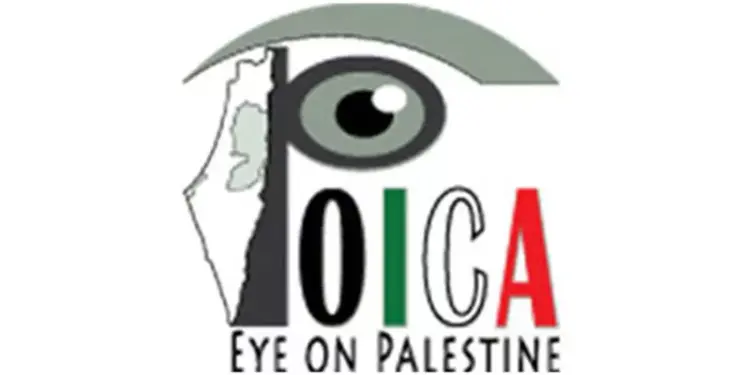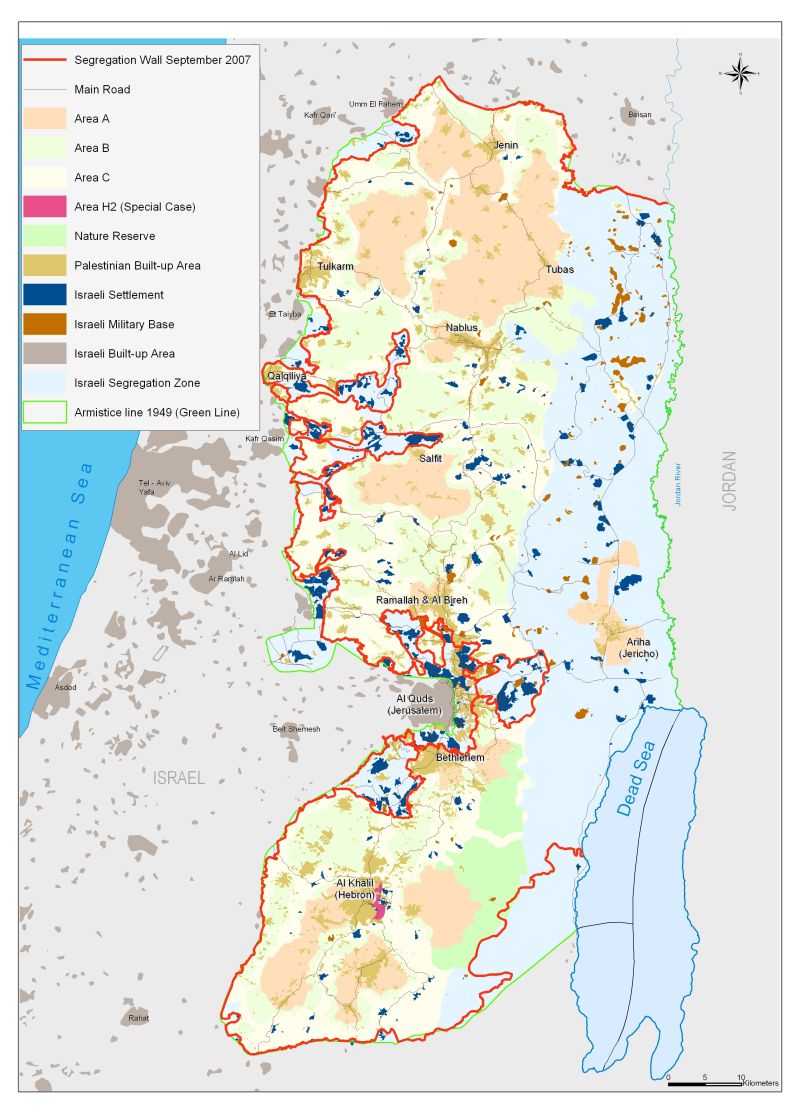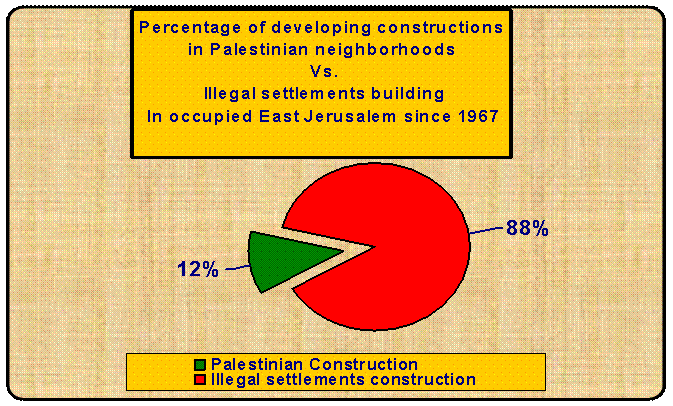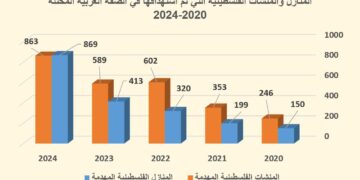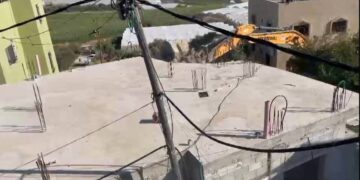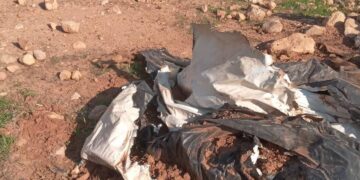Background
Throughout the course of the Israeli occupation of the Palestinian territory, the Israeli Army carried out a systematic campaign of demolishing Palestinians' houses in the occupied West Bank, with particular emphasis on East Jerusalem and Gaza Strip. After the signing of Oslo II Agreement between Israel and the Palestinian Liberation Organization (PLO) in the year 1995, Israel, had escalated its campaign against the Palestinian houses, especially those located in Area “C” (according to Oslo Agreement under full Israeli control) under the pretext of lacking building permits.
Following the eruption of the second Palestinian Intifada (Al-Aqsa Intifada) in September 2000, the Israeli intensified its demolition campaign against the Palestinians' houses and reached unprecedented levels.
The following table shows chronology between the year 2000-november 2009 demolished Palestinian houses in occupied West Jerusalem and the rest of the West Bank territory. It also shows number of demolishing orders for houses with demolishing orders during the same periods.
|
By Year |
Threatened Houses |
|
Demolished Houses |
|
|
|
WB + Jerusalem |
WB |
Jerusalem |
Total |
||
|
2000 |
465 |
20 |
21 |
41 |
|
|
2001 |
568 |
143 |
51 |
194 |
|
|
2002 |
641 |
231 |
63 |
294 |
|
|
2003 |
681 |
242 |
94 |
336 |
|
|
2004 |
703 |
173 |
80 |
253 |
|
|
2005 |
795 |
137 |
78 |
215 |
|
|
2006 |
505 |
186 |
44 |
230 |
|
|
2007 |
465 |
114 |
59 |
173 |
|
|
2008 |
431 |
20 |
83 |
103 |
|
|
Nov 2009 |
1411 |
54 |
76 |
130 |
|
|
|
|
||||
|
Total |
6665 |
1320 |
649 |
1969 |
|
The Dilemma of Building in Area C
According to the Interim agreement (OSLO II of the year 1995), the Palestinian territory was divided into areas A, B and C. In Area A, the Palestinian Authority had complete autonomy over administrative and security issues; where in area B, the Palestinians had civil responsibilities; while in Area C, Israel had full control over this area, which constitutes 61% from the total West Bank area.
At the same time, that Israel escalated its demolishing campaign of Palestinian houses, the Israeli authorities intensified the illegal building in the Israeli settlements and outposts throughout the Palestinian occupied territory, particularly in East Jerusalem. Furthermore, the Israeli Civil Administration had imposed burdensome requirements on the Palestinians asking for building permits to build in their lands, but even that was not enough thus they had no choice but to build without the building permits.
Hagit Ofran of the Israeli organization 'Peace Now” stated that during the period from 2000 until September 2007 the Israeli Civil Administration denied more than 94% of requests submitted by Palestinians for building permits. in fact, only 91 construction permits were granted to Palestinians, while in the same time period 18,472 housing units were constructed in the settlements (According to the Israeli Central Bureau of Statistics, completed construction in the Settlements from 2000 till September 2007)
Moreover, 4,993 demolition orders were issued against Palestinian construction, while 2900 against illegal construction in the settlements, however, 1,663 (33%) Palestinian buildings were demolished in this period, as opposed to 199 (7%) in the settlements.
Over the years of its occupation of the Palestinian land, Israel had demolished thousands of the Palestinian houses in the occupied territory, justified its actions by security and administrative pretexts, but the fact is that Israel had carried out its campaign to the interest of its own in order to:
- nnex the land to build the Illegal Israeli Apartheid Segregation Wall.
- Kick the Palestinians out of their lands to facilitate the annexation of their lands to the interest of building and expanding the Illegal Israeli settlements and their outposts.
- Construct the Israeli bypass roads grid, which is mainly founded to facilitate the movement of the Israeli settlers and military forces protecting the settlements. Houses lying alongside an existing or planned bypass road are designated for demolition.
- Remove the Palestinians from areas adjacent to the Illegal Israeli settlements.
- Control the lands in this area in order to prevent the transfer of these lands to the Palestinians and to keep them out of any future final agreement between the Israelis and the Palestinians.
The Palestinian residents of the villages and communities located in Area C are suffering from the absence of planning schemes to meet their needs, the lack of permits to build on their land, and the refusal of the Israeli Civil Administration to grant them building permits, and always under the threat of demolishing for building without permit or for just being there in an area declared by they Israeli Army as “closed military area.” Israel on the other hand have the bulldozers to deliver the answer to Palestinians who dare to defy the Israeli Army rules and build on their land in Area C, where they must undergo a prolonged, complicated, and expensive procedure which generally results in denial of the application. See Map 1
Map 1: The Classification of Lands in the West Bank Territory
The Israeli Systematic displacement Of Palestinian Jerusalemites
With the end of the Israeli War on the Gaza Strip, the support for the right wing parties and its allies soared beyond expectations, which indicated an unmistakable sign to what favors the majority of the Israeli community. That is what the newly elected self-proclaimed secular mayor of Jerusalem is seeking to achieve popularity using the Palestinian homes and dreams to pave the way toward the stardom of the Israeli political arena.
The fanatical campaign led by the Israeli municipality of occupied East Jerusalem against the Palestinian residents is another front of the Israeli war on Palestinian wherever the existed. Jerusalem is the heart of the Israeli – Palestinian conflict, and now, Israel has turned its face to Jerusalem with a vindictive intent to eliminate the Palestinian existence, and to discourage their spirits to squeeze them out of their own home city. To this end, the Israeli elected mayor who stated in his victory speech, 'I’m aware of the depth of the challenge and the complexity of the mission. Now is the time to work together for the good of the city.' Apparently, for the newly elected mayor of Jerusalem it means unlimited support for Jewish settlement in Palestinian neighborhoods and quick elimination of Palestinian dwellings marked “illegal” meaning that it has no proper authorization.
Between 2000 and 2008, the Israeli municipality of Jerusalem demolished 573 Palestinian Jerusalemites’ houses.
In 2009
Since the beginning of 2009 until the end of November, the newly elected mayor of Jerusalem, including occupied East Jerusalem commenced a direct campaign against Palestinian houses marked illegal and effectively started the demolishing campaign. Accordingly, the Israeli municipality of Jerusalem demolished 76 Palestinian structures and at least 908 others are pending demolishing.
What does it mean that Houses Demolished under the pretext “building without license”
Throughout its ongoing occupation decades, Israel purported demolishing Palestinian houses for various reasons, all of which evolve around 'security needs.” The variation of the Israeli pretext used to demolish Palestinian houses depended on the location of the house to be demolished. Israel always considered occupied East Jerusalem part of unified Jerusalem thus part of the Israeli State, which made the Israeli pretext to demolish houses for security purposes invalid; instead; the Israeli municipality of Jerusalem demolished Palestinian houses in East Jerusalem for build without license.
Demolishing houses under this pretext usually takes place in areas located in close proximity of Israeli settlements and within the Israeli defined boundary of occupied East Jerusalem. Over the years, Israel imposed various restrictions on building process carried out in occupied West Bank, with particular emphasis on East Jerusalem. Building in areas that fall outside the master plan of Palestinian towns and villages required and still do; building permit from the Israeli civil administration; otherwise the construction will be subject to demolishing at any time by the Israeli Army.
Under international law, the occupying power is not to interfere with issues of civil concerns and is not to demolish property of those occupied unless military necessities demand that they do so. In Jerusalem, the situation was somewhat different from the rest of the West Bank, where the Israeli civil administration has no jurisdiction there; thus, it was for the Israeli municipality of Jerusalem and the Israeli ministry of interior to carry out the demolishing process.
So why the Palestinians build in-spite of Demolishing threat
In its obvious mission of the Judaization of Jerusalem, the Israeli government has created laws and implemented policies to the great disadvantage of the Palestinian people. The pressures applied on the Palestinian of Jerusalem in that process were enormous, and can be summarized in some of the following political and legal problems:
Land Control
A powerful tool applied by the Israeli government to further its expansionist policies in Jerusalem was the use of land control mechanisms. These mechanisms, which involved land confiscation, as, described in the section below, and structural planning and zoning practices were detrimental to the Palestinian people of East Jerusalem.
Structural Planning and zoning ordinances, as applied by the Israeli government and the Israeli municipality in Jerusalem, are unlike any other anywhere else. With the only objective of the Judaization of Jerusalem, structural planning in Jerusalem has resulted in the following land use concerning the Palestinian lands in Jerusalem:
1. Thirty four percent of Palestinian land confiscated for Israeli Settlement purposes.
2. Forty percent classified as “Green Areas” where no Palestinian development can occur.
3. Six percent of land for roads and infrastructure
4. Seven percent un-zoned
5. Three percent frozen
6. Only ten percent for Palestinian development.
It is worse enough that the only 10 percent left for Palestinian to develop on are mostly utilized, but also, Palestinians could not expand vertically. The Israeli government has made it such that Palestinians are only allowed to build one or two stories high. The settlers, on the other hand, are allowed to build eight stories high. Further, while Palestinians are only allowed to a building to land ratio of 50 to 70 percent, Israeli settlers are allowed up to 200 percent.
Restricting of Palestinian Development
The Israeli government has employed city structural planning for restricting Palestinian development in the city. The Israeli municipality has defined 40 percent of Palestinian land as “Green Areas.” These are areas where no construction activities can take place. In other word, 40 percent of the Palestinian lands in Jerusalem have lost their economic value to the huge economic loss of the Palestinian people of Jerusalem.
The “Green Area” classification of lands only applies to Palestinians. This classification can be changed if a Jewish settlement will be built on the land. In 1973, the Israeli settlement of Ramot was built on land classified as “Green Area” in 1968. The land was confiscated from the Palestinian neighborhood of Shua’fat. Over 2500 housing units were built over 500 acres of this land.
Another more recent example of lifting the “Green Area” classification of lands was the case of Jabal Abu Ghanim (Har Homa). Over 2000 Dunums of “Green Area” were reclassified for housing development for Jewish settlement purposes. The new plans call for the construction of 6500 housing units for the Ultra Orthodox Jewish community.
To illustrate the impact of the “Green Areas” on Palestinian land, the Jabal Mukaber neighborhood in East Jerusalem has over 15,000 Palestinian residents living on an area of 570 Dunums. The Israeli municipality has declared 411 Dunums of the neighborhood as “Green Areas” leaving the population of the neighborhood with 117 Dunums to live on.
House Demolition
The demolition of Palestinian homes and driving them out of the city has been a policy of the Israeli government since the occupation of the city in 1967. Soon after the occupation, the Israeli government demolished 115 homes in the Maghrebi quarter to accommodate Jewish prayers near the Western Wall. The demolition of homes continues today under the pretext of “building without a permit.”
On average, the Israeli government demolishes 50 homes per year. A total of 309 homes were demolished between 1987 and 1999.
Today, more than 8000 Palestinian houses in Jerusalem live under the threat of demolishing by the Israeli municipality of occupied East Jerusalem. In short, the Israeli housing discriminatory practices against Palestinians in Jerusalem resulted in the construction of over 88 percent of the units for Jewish settlers and only 12 percent of the units for Palestinians since 1967 (see chart 1). This has resulted in a density of 17,245 Palestinian inhabitants per square kilometer and 5,340 Israeli settlers per square kilometer.
Legal & International Status
Israel continues to demolish Palestinians' houses in large numbers under false and illegal justifications to serve their end purpose, to uproot and to drive out as many Palestinians from their homes and lands to build more Illegal Israeli settlements, outposts, bypass roads, military bases. The Israeli Segregation Wall is the tool that Israel is using to set its eastern borders for the first time it was declared a state, more than that the Wall intended to deplete the isolated Palestinian communities and lands from the Palestinians using all possible methods starting with movement restriction, manipulating access permits and access time in and out of the isolated zone, which will be mostly unbearable for sick individuals and tough on people accessing their work locations, or student going to schools and universities.
According to Oslo Agreement, redeployments from Area C and transfer of internal security responsibility to the Palestinian Police in Areas B and C will be carried out in three phases, each to take place after an interval of six months, to be completed 18 months after the inauguration of the Palestinian Council in 1996, except for the issues of permanent status negotiations and of Israel's overall responsibility for Israelis and borders. However, Israel did not to its commitment, or refused to so at least until it carryout its own agenda starting with settlements expansion, building the Segregation Wall, and most importantly fortifies its grip over, or shall we say around Jerusalem.
To conclude,
The long and extensive history of the ongoing Israeli house demolition policy in the occupied Palestinian territory does not only constitute a grave breach of Palestinian right to housing, but also an application of the prohibited 'collective punishment' as emphasized in the Fourth Geneva Convention of 1949; Article 33, which strenuously rebut without exception; infliction of punishment on an individual/s for an act committed by another.
Art. 33. No protected person may be punished for an offence he or she has not personally committed. Collective penalties and likewise all measures of intimidation or of terrorism are prohibited
In addition to article 33 of the Geneva Convention, Israel's house demolition policy in the occupied Palestinian territory was never based on military necessities as indicated in Article 53 of the Convention but merely on vindictive reasons as collective punishment and in Jerusalem; house demolition is carried out to clear Palestinian houses for the illegally built Israeli settlements.
Art. 53. Any destruction by the Occupying Power of real or personal property belonging individually or collectively to private persons, or to the State, or to other public authorities, or to social or cooperative organizations, is prohibited, except where such destruction is rendered absolutely necessary by military operations.
Article 23 of the Hague Convention of 1907 also provide: In addition to the prohibitions provided by special Conventions, it is especially forbidden to destroy or seize the enemy's property, unless such destruction or seizure be imperatively demanded by the necessities of war;
Article 147 of the Fourth Geneva Convention indicated that: Extensive destruction and appropriation of property not justified by military necessity and carried out unlawfully and wantonly. is a grave breach of the Convention.
Under United Nations Security Council (UNSC) resolutions 252, 267, 271, 298 East Jerusalem is an occupied city.
UNSC 252
2. Considers that all legislative and administrative measures and actions taken by Israel, including expropriation of land and properties thereon, which tend to change the legal status of Jerusalem are invalid and cannot change that status;
3. Urgently calls upon Israel to rescind all such measures already taken and to desist forthwith from taking any further action, which tends to change the status of Jerusalem;
UNSC 276
- Censures in the strongest terms all measures taken to change the status of the City of Jerusalem;
- Confirms that all legislative and administrative measures and actions taken by Israel which purport to alter the status of Jerusalem, including expropriation of land and properties thereon, are invalid and cannot change that status;
- Urgently calls once more upon Israel to rescind forthwith all measures taken by it which may tend to change the status of the City of Jerusalem, and in future to refrain from all actions likely to have such an effect;
UNSC 271
2. Recognizes that any act of destruction or profanation of the Holy Places, religious buildings and sites in Jerusalem or any encouragement of, or connivance at, any such act may seriously endanger international peace and security;
UNSC298
4. Urgently calls upon Israel to rescind all previous measures and actions and to take no further steps in the occupied section of Jerusalem which may purport to change the status of the City or which would prejudice the rights of the inhabitants and the interests of the international community, or a just and lasting peace;
Moreover, the Universal Declaration of Human Rights adopted and proclaimed by General Assembly resolution 217 A (III) of, December 10, 1948, Article 17 reads: 'No one shall be arbitrarily deprived of his property.' Which means it bans Israel from destroying or confiscating the property of the Palestinians at any case.
Finally, the International Convention on the Elimination of All Forms of Racial Discrimination (1965) Article 5 provides that 'States' Parties undertake to prohibit and eliminate racial discrimination in all of its forms and to guarantee the right of everyone, without distinction as to race, color, or national or ethnic origin, to equality before the law, notably in the enjoyment of the following rights: … (e) in particular … (III) the right to housing'.
Prepared by:
The Applied Research Institute – Jerusalem


